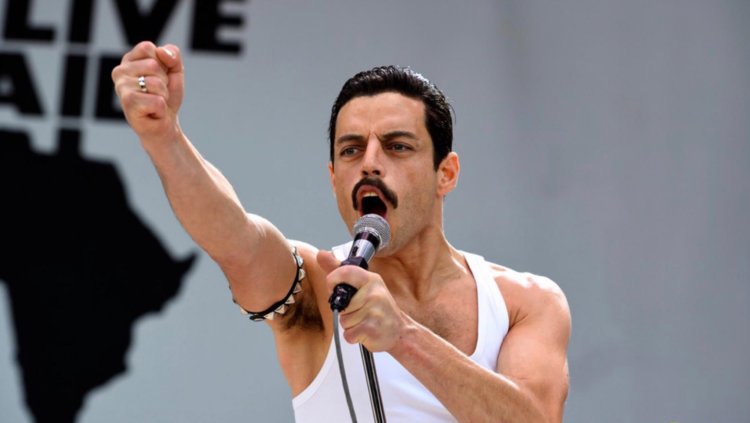‘Bohemian Rhapsody’ (2018), the biopic on the rock legend Freddie Mercury, has received polarising reviews despite being a box-office success owing to several historical inaccuracies throughout the narrative. Here’s a closer look at a few of them…
‘Bohemian Rhapsody’ first shows Freddie Mercury (portrayed by the talented Rami Malek) as a young man in 1970 handling baggage at Heathrow airport, which is true, as that was one of his early occupations, along with selling second hand clothes at Kensington Market later with then girlfriend Mary Austin. He was also a part of a series of bands during this time.
The narrative differs from how Mercury met his future Queen band mates. It is true that he had been a fan of ‘Smile’ the band consisting of Roger Taylor, Brian May and Tim Staffel and regularly attended their performances, Mercury didn’t exactly meet them as depicted in the film, where he is shown to be interacting with them following a performance, after which he impresses them with his vocal abilties. However, Tim Staffel did leave ‘Smile’ to be a part of the group ‘Humpy Bong.’
‘Angry Lizard’ Freddie Mercury (Rami Malek) in a scene from ‘Bohemian Rhapsody’ (All pics courtesy YouTube)
In reality, Staffel and Mercury attended Ealing Art College together, after which the former introduced the man, who was previously known as Farrokh Bulsara (Freddie’s birth name), to Roger Taylor and Brian May. Mercury would soon become a keen fan and follower of Smile before joining them as lead vocalist following the departure of Staffel as stated earlier.
Also, the introduction of bassist John ‘Deacy’ Deacon as a full member immediately is inaccurate. Deacon, auditioned for a spot on Queen in early 1971, in a lecture room at Imperial College, London. He had seen Queen perform in October 1970 but wasn’t impressed and had went on to form a band named Deacon and performed at Chelsea College. Showing him as an original member might be attributed to creative licencing by the makers.
Freddie Mercury referred to Mary Austin (pictured right) as his ‘Common-law wife’
Mary Austin was introduced to Freddie Mercury by Brian May. Their first meeting was not at a bar during a Smile performance, as shown in ‘Bohemian Rhapsody.’ ‘Keep Yourself Alive’, the first song of Queen’s eponymous debut 1973 album, was penned by May. The biopic shows Mercury taking his liberties with the lyrics during the live performance, something that the spontaneous singer was known to do, according to some sources. Queen’s first gig in their classic lineup was on July 2nd, 1971, was at a Surrey college outside London.
What’s in a name? Absolutely everything, if you’re destined for greatness, according to some. Freddie flippantly declares in a scene from ‘Bohemian Rhapsody’ that he has legally changed his name to Mercury, much to the chagrin of his conservative Parsi parents. The legendary crooner was inspired by the lyric “Mother Mercury, look what they’ve done to me” in the track ‘My Fairy King,’ which eventually led him to take this decision. Others who were close to him opine that he always wanted to be Numero Uno, like the planet Mercury. Additionally, Brian May is an astrophysicist as stated in the film, having obtained his PhD in astrophysics from Imperial College, London. He began work on his thesis in 1971 and completed it in 2007. Similarly, drummer Roger Taylor did study dentistry at the London Hospital Medical College but switched to biology after losing interest earning a BSc at East London Polytechnic.
John Deacon, who retired in the years following Mercury’s passing, is an electrical engineer having acquired an interest in electronics at an early age. He built small devices most notable of which was a modified reel-to-reel tape deck, which could record music directly from the radio.
In Bohemian Rhapsody, Freddie Mercury convinces his Queen band mates to sell their van to produce their debut album. They proceed to do so after which they are spotted by a record executive, which leads them to bag a deal with EMI Records. This is faithful in part, because they did compile a demo tape consisting of future hits ‘Liar’, ‘Keep Yourself Alive’, ‘The Night Comes Down’ and ‘Jesus’ among other songs, and shopped them to various record companies, who failed to show them any interest.
Queen were spotted by De La Lane Studios executive John Anthony in 1972 following which they entered discussions with Trident Studios. They were allowed to utilise state-of-the-art recording facilities used by other legendary musicians like The Beatles and Elton John. This was possible by a management deal under Trident subsidiary Neptune Productions, while a record label will be searched for them, which was offered by Norman Sheffield. They could only use the studio’s facilities during down time that is the wee hours of the morning, which Roger Taylor called “gold dust.” They ended up signing officially with Trident/EMI, which was preceeded by the release of their first album in 1973.
Queen did indeed tour the United States in 1974, following their signing and album release, but, what wasn’t shown was that guitarist Brian May was diagnosed with hepatitis a month after this and was sidelined only returning when they began work on their third album ‘Sheer Heart Attack’ which released the same year. Killer Queen was part of Queen’s live line-up between 1974 and 1981 as the film suggested. Following his recovery Brian May was able to finish the song with his band members.
Mercury in a still from the music video for ‘Fat Bottomed Girls’ (1978)
What was anachronistic was the early inclusion of the song ‘Fat Bottomed Girls’ which featured in Queen’s 1978 album ‘Jazz.’ It was included during the pastiche depicting the band’s live US performances in 1974 and 1975, which was not actually the case. Also, Mercury sported an entirely different costume in the track’s official music video, which saw him miming the lyrics while donning pants held up by suspenders and white casual shoes. He was shirtless.
The band’s fallout with EMI following the composition of their magnum opus ‘Bohemian Rhapsody’ (the film’s name is derived from this song’s title), could be considered highly fictional. While it is agreed that various studio executives suggested they avoid releasing the song as a single due to it’s length: 5 minutes and 55 seconds, their split with the record label didn’t occur at this time. In fact, both parties acrimoniously parted ways in September 1975, a couple of month before the release of ‘A Night at the Opera’ (which featured Bohemian Rhapsody in the track list) after a fallout with Sheffield. In fact, Mercury targeted Norman Sheffield by writing the song ‘Death on Two Legs (Dedicated to…)’ which was the first track on ‘A Night At the Opera’ album. It was a scathing attack on his former manager and Trident Studios owner, which led to the latter hitting back by taking legal action against the band and the record label for defamation. Sheffield denied mistreating the band in his 2013 autobiography ‘Life on Two Legs: Set The Record Straight.’
(Clockwise from left) John Deacon, Brian May, Roger Taylor and Freddie Mercury in a still from the music video for ‘Bohemian Rhapsody’ (1975)
Freddie Mercury’s trademark use of a broken microphone stand, happened when he was part of a band named Wreckage in 1970 during their final show. The upper shaft of the stand broke away at the base when he attempted to lift it above his head. He would then continue to use it as a prop pretending it’s a guitar and whipping it around. It didn’t happen during Queen’s first live gig as portrayed and he didn’t meet future lover Mary Austin on the same day.
Mercury wasn’t immediately accepted as lead singer by Smile and would coax them for months to include him. He, Brian May, Roger Taylor and Tim Staffel (who would teach guitar chords to Mercury) were actually roommates in Barnes, a Thames-side village in London. He and May sold antiques, art and clothing at stall in Kensington Market. There’s a famous story of a young Freddie convincing singer David Bowie to buy a pair of boots from his stall. Both would later collaborate for the song ‘Under Pressure’ in 1981. The song’s opening riff was used in the Vanilla Ice track ‘Ice Ice Baby’ later.
The track ‘Love of my Life’ was introduced during Queen’s 1977 ‘News of the World’ album tour and not before Freddie Mercury’s break-up with Mary Austin, as the narrative implies. Also, Freddie came out to Austin after entering a sexual affair with a male American record executive. It is true that ‘Love of my Life’ was written on Austin. As for the song ‘Bohemian Rhapsody’, Mercury wrote and composed the entire song by himself and there was several overdubs while recording, and it was called ‘Fred’s Thing’ during this time, which is true to the proverbial source.
A still from the music video for ‘We Will Rock You’ (1977)
Another anachronism is the year in which Queen’s arena rock anthem ‘We Will Rock You’ came to be. It was written and composed by guitarist Brian May and was the first track on their 1977 album ‘News of the World’ and was not created in 1980 as shown in ‘Bohemian Rhapsody.’ May was inspired to write as a song that would involve audience participation after an experience during a live show when members of the audience spontaneously sang the show tune You’ll Never Walk Alone, following an encore. A music video was filmed in Roger Taylor’s mansion’s back garden along with ‘Spread Your Wings.’ ‘We Will Rock You’ was released as a single along with ‘We Are the Champions’ and both songs would be performed together live on several occasions.
What is accure is that, Freddie Mercury did approach friend and Capital Records radio DJ Kenny Everett with a copy of his song Bohemian Rhapsody (as suggested by producer Roy Thomas Baker, who produced Queen’s first four albums), when studio executives expressed their reservations about releasing it as a single citing it’s length. Everett did play it on his show in fact on one occasion he played the track 36 times, which led to the station getting flooded with calls regarding when it would be released. Although met with mixed contemporary reviews, Bohemian Rhapsody has acquired legendary status in the following years.
A perfect case of total recall is seen when bassist John Deacon comes up with the famous opening riff to ‘Another One Bites the Dust’ (1980), which would become a worldwide hit for them. The film shows this Eureka moment, when Deacon decides to break up a confrontation between Mercury and Taylor by playing the riff. The bass line was actually inspired by disco group Chic’s song ‘Good Times’ as revealed by the band’s co-founder Bernard Edwards in an interview.
Creative freedom runs rampant throughout the film’s timeline, as Mercury’s meeting with future partner Jim Hutton was never at the singer’s residence following the party. Hutton was a hairdresser and did not work for Freddie when the latter decided to host a house party. They met somewhere in 1985 and were together until Freddie Mercury’s death following a battle with AIDS in 1991.
The depiction of Freddie Mercury’s AIDS diagnosis in ‘Bohemian Rhapsody’ has received considerable criticism by fans and critics alike and rightfully so. The legendary singer was diagnosed as HIV postive in 1986 and discovered he had AIDS in April 1987 as per partner Jim Hutton’s later interview revelations. He wasn’t aware of his disease befor the 1985 Live Aid performance.
Mercury’s relationship with manager Paul Prenter (Allen Leech) is explored in ‘Bohemian Rhapsody’ with the latter being presented somewhat as the villain of the piece. Prenter, who himself died to AIDS, a few months after Freddie, managed the singer between 1977 and 1986 and both were lovers. Queen band members have be critical of his influence and involvement witht their work especially the 1982 album ‘Hot Space’ in which the band made a significant shift in musical style to a more radio-friendly sound such as pop rock and disco. Queen’s early work consisted of hard rock, progressive rock and heavy metal musical styles.
Prenter, who has been labeled by Queen’s fans as ‘Judas’ for participating in a tell-all television interview detailing Mercury’s sexual escapades with various gay lovers even going as far as to suggest that two of the singer’s bedmates died of AIDS, was to a certain extent properly portrayed as far as these details are concerned.
Freddie Mercury and former fiance Mary Austin did live in adjacent homes following their split. He was even the godfather to Austin’s oldest son Richard. Mercury final home, Garden Lodge, 1 Logan Place, a twenty-eight room Georgian mansion in Kensington set in a quarter-acre manicured garden surrounded by a high brick wall, had been picked out by Austin, which he left to her in his will rather than to partner Jim Hutton.
As portrayed, Queen members especially Freddie Mercury were hounded by the press over the famous singer’s personal life especially his sexuality and clandestine homosexual relationships. The singer never outright admitted to being gay and didn’t support any gay rights causes in his life. Bohemian Rhapsody shows him frequenting gay night clubs with lover Paul Prenter, which could have been constructed based on anecdotes from others.
What is worth mentioning is actor Rami Malek’s masterful portrayal as Freddie Mercury, in which he is able to mimic the late singer’s mannerisms, speech, voice and even performance style adeptly. In fact, Malek studied Freddie Mercury’s 1985 Live Aid concert performance about 1,500 times to replicate it exactly on screen. We give him high praise for achieving this.
Freddie Mercury, who was a piano virtuoso, performing at Live Aid (1985)
Finally, Queen did decide to credit every song they worked on to all the members instead of just one, and they never disbanded as shown in ‘Bohemian Rhapsody’ following Freddie Mercury’s decision to record a solo album titled ‘Mr. Bad Guy’, which released in 1985. Mercury did reveal his medical condition to his fellow band members following which they stopped touring and recorded albums most notably ‘The Miracle’ and ‘Innuendo’ until Freddie’s death in 1991.
Freddie Mercury in a still from the music video for ‘I Want to Break Free’ (1984). The video was supposed to be a parody of the long-running UK television series ‘Coronation Street.’ He also features sans his trademark moustache later in the same video
Sidebar
In a scene following the shooting for the music video for ‘I Want to Break Free’ Freddie Mercury blames drummer Roger Taylor for suggesting they perform in drag, which is exactly how that idea came to be.
Jim Beach was certainly nicknamed ‘Miami’ by Queen members as a play on his last name. A lawyer by profession, he would go on to manage the group.
John Reid was Queen’s manager between 1975 to 1978


















